If you were looking for this mythical “internet of things” at the 2014 International CES tech trade show last week, you didn’t have to go much farther than the Broadcom booth. When it comes to powering the internet of things or wearables, Broadcom specializes in it.
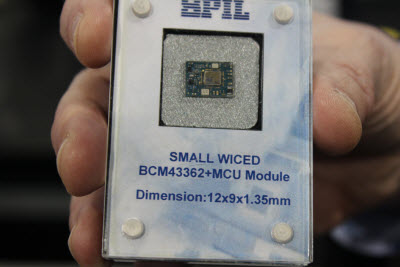
Above: Broadcom’s multi-protocol WICED chip
The communications chip maker had $8 billion in revenue in 2012 and it is charging into new markets for semiconductors. The backbone of the internet of things will depend on tiny processors, sensors, and communications devices that companies like Broadcom make. Broadcom makes chips that make things smarter, from cars to dog collars. So a tour of Broadcom’s chips gives us a window into the future of gadgets that will appear a year or two down the road.
We took that tour at CES with Scott McGregor, chief executive of Broadcom, which is competing with Intel and a bunch of other chip makers to lay the foundation for the internet’s future. Here’s an edited transcript of our interview about the opportunities that lie ahead.
VentureBeat: The internet of things is big. Wearables are big. What are the underlying technologies that have to be put into place for this next wave of whatever you call it – computing after the PC and after smartphones?
Scott McGregor: For wearables and the internet of things, the core technology is connectivity, because these are devices that enable connectivity for other things. We believe the right way to approach this market is around the core of connectivity, and we add to that integrated processors, integrated power management, memory, all those things. Sensor hub integration. We create a single device, which we call our WICED family, that has either Bluetooth or Wi-Fi or NFC or some combination of those.
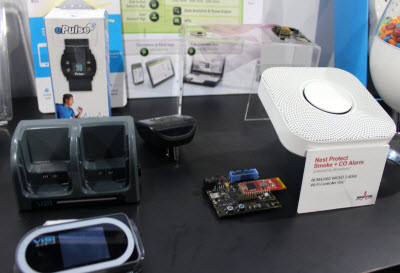
Above: Broadcom chips power internet of things devices like Nest.
VB: You don’t necessarily care which one?
McGregor: No. We’re agnostic about what standards they use. For many devices, you have to think about whether it’s a cluster around your smartphone, or if it’s a cluster around your Wi-Fi access point, or if it’s broader than that. Many of these devices will use your smartphone to get out to the internet. They do that to save on power and things like that. Bluetooth low energy is a perfect technology for that. Others—The NEST smoke detector is a great example. It uses Wi-Fi to create a mesh net where they all communicate and transmit information.
We see different kinds of protocols and standards for different kinds of products, based on the range and the use model. Wearables tend to be more Bluetooth-related. Things like your refrigerator will use more of a Wi-Fi connection. Our goal is to create single devices that integrate everything you need to build to the internet-of-things connection. We want to make that affordable and low-power and small and reliable.
This is Bluetooth and a processor and power management and memory and the analog bits to do an internet-of-things or wearable device. If you wanted to do a watch or some other type of device like that, it’s everything you need. It’ll run on a coin cell for a year or more. Very integrated, very easy to do. It’s an FCC-certified module, so it makes it easy for people, even smaller companies, to get to market very quickly.

Above: Broadcom chips power the iGrill
We have some examples of applications here, just a few cool ones. You’re familiar with the watches. Garage doors. Intelligent light bulbs. Lots of intelligent outlets. This one, you can change the color remotely. Hearing aids. This is the iGrill. You’re watching the football game inside and you stick this in the meat on your grill. It uses wireless LAN to talk to your smartphone and tell you what temperature the steak is.
VB: I saw a basketball with sensors in it.
McGregor: Football helmets, we’ve got one of those. It does impact detection and measurement. These are just some examples of the things we’re working on. They show the kinds of technologies you want to have in there.
We have some competitors who view this as a processor problem or something else like that. We view it as an integrated system. We provide everything in one piece. We’re seeing pretty good traction there. Would you like to see automotive, or 4K by 2K, HEVC?
VB: Is there anything new on location?
McGregor: Absolutely. This is GPS and navigation. We’re putting it into very small devices and wearables, so they have location. This here is really cool. Broadcom and Verizon will be announcing this. It’s a way to use Wi-Fi to very accurately – within a meter, a meter and a half – tell where you are located indoors, using what you already have in your smartphone. Very low power. It doesn’t require GPS or anything like that.

Above: Broadcom chips and OmniTrail software power this “precise presence” retail demo.
Stores could use this for customer loyalty and other kinds of things. Let’s say you entered a Verizon store. They would know who you are and that you’re eligible for a free upgrade today. What Verizon wants to do, using technology from OmniTrail that we’ve implemented in the firmware on our chips, is to enable their enterprise networking customers and retailers to create this opportunity and make offers to customers.
Companies that produce multiple devices, for the home and for mobile – let’s say Samsung, for instance – could benefit from this in their device ecosystem. You enter your house. The television changes channels. The thermostat sets itself. All sorts of events could happen.
VB: Your watch could tell you that you have a deal coming your way.
McGregor: Think of it as something consumer-friendly, too. I like the idea of my home setting itself to the right temperature, or fixing the ambient light how I like it. The trick is, you can do this with other technologies, but this will come already enabled with the Wi-Fi stuff you have in your phone. The access points are able to determine it all.
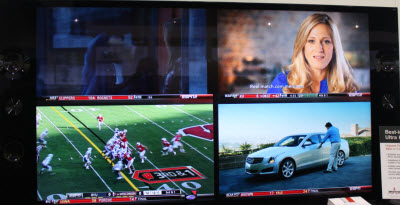
Above: A 4K TV can power four HD streams.
VB: Is Wi-Fi going to be low-power enough at some point? Do they have the road map for that?
McGregor: Well, the Wi-Fi module I just showed you over there will run on a flashlight battery for a year. One of the things we’ve done on the power front is that between the times that the Wi-Fi is doing its work, we drop to an incredibly low-power state. It’s less than 10 microamps. On 10 microamps, you can sit on a battery for a very long time. It still has the standard Wi-Fi range.
Here’s 4K by 2K. The thing that’s important is to drive 4K by 2K and make it possible. Everyone fixates on this, because that’s what you as a user will see. It’s essentially four HD panels simultaneously. The technology that enables this is something called HEVC. It’s like the next MPEG technology – think of it as MPEG-5. It compresses the video data by another factor of two. You can do four HD channels in the equivalent of two. It’s not a free lunch, but you’re buying two and getting four. A lot of the satellite guys, the cable guys, Netflix, all of them will be rolling out HEVC technology to enable the 4K by 2K stuff.
It’s important for us because we’re building a whole family of devices that support HEVC. That’s the enabling technology that will make this all happen. We have partnerships with pretty much everyone in the industry doing this.
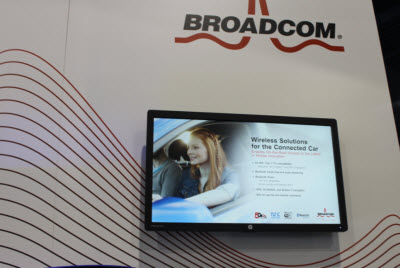
Above: Broadcom chips bring the internet to cars.
VB: Will this become relevant to what we were talking about with the internet of things, or is it more just about TV and 4K video?
McGregor: It’s TV and 4K video, not so much the internet of things. Let’s take a look at cars. The internet of things ties into cars in a lot of ways. For a long time, cars have been their own sort of backwater. We’re doing two things. One, how do you connect the wired networks in cars and replace that so they can do higher speed and lower cost?
We have an Ethernet technology, Broader Reach Automotive Ethernet, and it’s being shipped by BMW. We just launched in the new BMW X5. It’s been many years in the making. They use it for all the cameras and the surround view and stuff like that. We’re working with a bunch of automotive guys. This will become the basis for the whole wired end of things. Meanwhile, we also want to do wireless. We have wireless in there as well. All the wireless LAN and Bluetooth, creating a whole environment connected together in the car, which can enable all kinds of other devices.
T
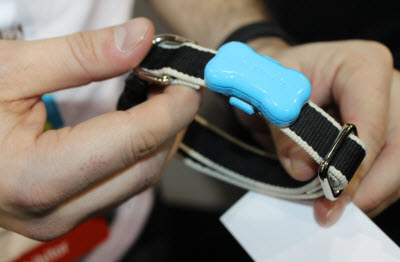
Above: Broadcom chips could power FitBark smart dog collars.
he key thing here is, think about being a car manufacturer. You have these people bringing phones and other things into the car. How can you make that relevant? One of the things we’re doing is working it out so they provide a screen in the car, and then you bring your own smartphone. Instead of spending $2,000 on a navigation system for your car, you bring your smartphone into the car and you have a display for it. It handles all that for you. Making all that stuff work seamlessly is a big project here.
Basically, your car is becoming the next mobile device. The same things you’d do with your smartphone or tablet, you’re doing them in the car as well. It’s part of the connected ecosystem. You can share content between your phone and your TV. You should be able to do the same thing between your phone and your car.
Wearable devices tether to the smartphone. The smartphone tethers to the car. It’s all linked together. If you’re tracking your heart rate on your phone, you could track it on your car display as well. Glucose, blood alcohol, all that stuff. My kids are going to be wearing the bracelet when they turn 16. [laughs]
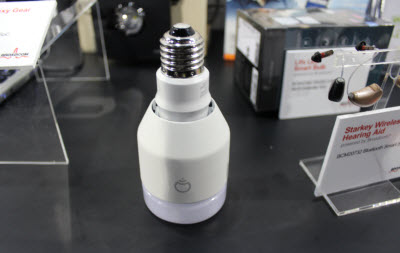
Above: Broadcom chips power a connected light bulb.
VB: The competition here seems to be pretty close to a free-for-all, in the internet-of-things space.
McGregor: Not so much, I think? We don’t know of anyone else who has this level of integration in systems. There are people who will sell you processors or sensors or other things, but we integrate everything except the battery and the sensor. It makes for complete solutions.
We’re going to change our business model a bit in the next year, to give us more of a channel. In addition to selling to the big guys, which we do well, we’ll go to more of a channel model. If you look at guys like FitBark, that’s one and a half engineers. That’s the whole company. How do you support somebody like that and enable them to succeed, so they can grow into something bigger? Another example is Roku. They were a very small company. Now they’re pretty big.
VB: The switch to channel helps that in what way?
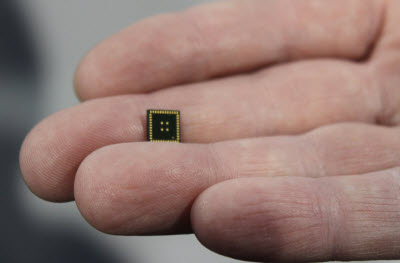
Above: A processor for the internet of things
McGregor: The channel makes it possible for them to buy smaller quantities of devices. We’re going to provide a support portal so that they can place self-service orders.
VB: Almost like the mass customization that comes from 3D printing hardware.
McGregor: Raspberry Pi is a great example, where they’ve taken our chip and built a whole ecosystem out of it. It’s working pretty well now. It’s totally self-supporting. People are doing all kinds of stuff with Raspberry Pi, like 3D printers.
The volume in that kind of thing can be slow at the beginning. We saw a company that makes a 3D printer that prints in chocolate. I think that’s a totally cool device myself. [laughs] But it’s not going to be a huge market impact. How does somebody like that get support and technology? We’re working on different ways to cascade that.




 Wearable shipments will hit 130M by 2018, but are not yet a ‘must-have’
Wearable shipments will hit 130M by 2018, but are not yet a ‘must-have’



![Reblog this post [with Zemanta]](http://img.zemanta.com/reblog_e.png?x-id=03cb076a-852a-4caf-aef3-f958574d2605)

